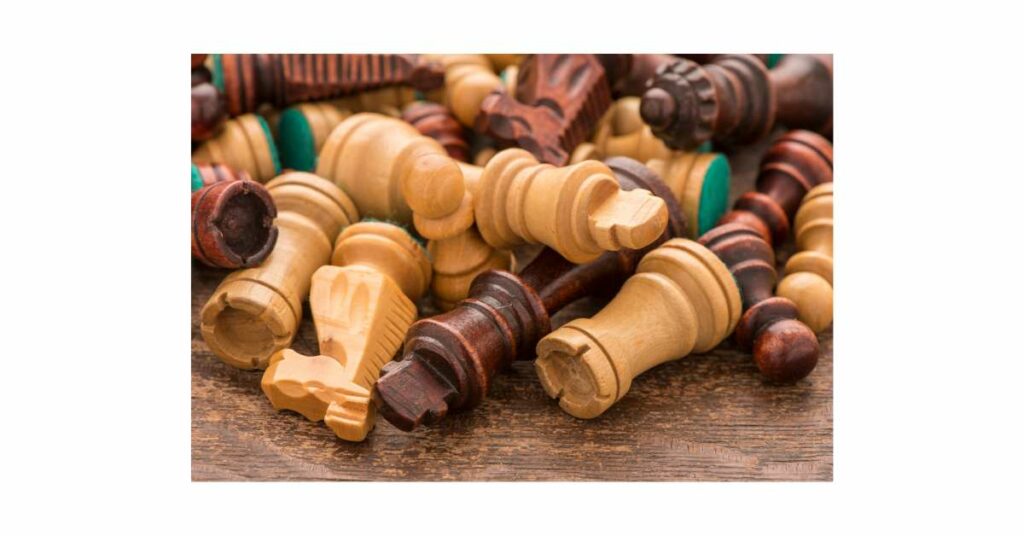Chess is a game that has been around for centuries and has been enjoyed by millions of people around the world. To play chess, you need to have a good understanding of the different chess pieces and their movements.

In this article, we will provide you with a complete guide to chess pieces that will help you understand how each piece moves and how to use them to your advantage.
The chessboard consists of 64 squares, with each player starting with 16 pieces: one king, one queen, two rooks, two knights, two bishops, and eight pawns. Each piece has a unique way of moving, and understanding their movements is crucial to winning the game.
The king is the most important piece on the board, and it is the player’s objective to protect their king at all costs while trying to capture the opponent’s king.
In this guide, we will explain the movements of each chess piece, including the king, queen, rook, bishop, knight, and pawn. We will also provide you with some tips and strategies on how to use each piece to your advantage and win the game.
Whether you are a beginner or an experienced player, this guide will help you improve your chess skills and become a better player.
Understanding Chess Pieces
In this section, we will discuss the different chess pieces and their movements. Understanding the chess pieces is crucial for mastering the game of chess.
Pawns
Pawns are the smallest and most numerous pieces on the board. They are represented by small, cylindrical pieces. Pawns can only move forward one square at a time, except for their first move, where they can move two squares forward. Pawns capture diagonally and can only capture a piece that is one square diagonally in front of them.

Bishops
Bishops are represented by tall, pointed pieces. Each player starts with two bishops, one on a white square and one on a black square. Bishops can move diagonally any number of squares, as long as there are no other pieces in the way.
They can only move on squares of the same color they started on.

Knights
Knights are represented by horse-shaped pieces. Each player starts with two knights. Knights move in an L-shape, two squares in one direction and then one square perpendicular to that direction.
Knights are the only pieces that can jump over other pieces.

Rooks
Rooks are represented by tall pieces with a castellated top. Each player starts with two rooks, one on each corner of the board.
Rooks can move horizontally or vertically across the board on any number of squares, as long as there are no other pieces in the way.

Queen
The queen is the most powerful piece on the board. It is represented by a tall, pointed piece with a crown on top. Each player starts with one queen.
The queen can move diagonally, horizontally, or vertically any number of squares, as long as there are no other pieces in the way.

King
The king is the most important piece on the board. Each player starts with one king. The king can move one square in any direction, horizontally, vertically, or diagonally. The king is also the only piece that cannot be captured.
In conclusion, understanding the movements of each chess piece is essential for playing the game of chess effectively. By familiarizing ourselves with the different chess pieces, we can develop strategies and tactics to outsmart our opponents.

Basic Chess Rules
Chess is a two-player board game that involves moving pieces on a checkered board to capture the opponent’s king. In this section, we will cover the basic rules of chess that every beginner should know.
Chess Moves
Each player starts with 16 pieces, including a king, a queen, two rooks, two knights, two bishops, and eight pawns. The goal is to checkmate the opponent’s king, which means putting it in a position where it is under attack and cannot escape capture.
Each piece has its own unique way of moving. The king can move one square in any direction, while the queen can move diagonally, horizontally, or vertically any number of squares. The rook moves horizontally or vertically any number of squares, and the bishop moves diagonally any number of squares. The knight moves in an L-shape, two squares in one direction and then one square perpendicular to that. The pawn moves forward one or two squares on its first move and then one square forward on subsequent moves.
Check
When a player’s king is under attack, it is said to be in check. The player must get out of check on their next move, either by moving the king to a safe square, blocking the attack, or capturing the attacking piece. If a player cannot get out of check, they lose the game.
Attacking
To capture an opponent’s piece, a player moves one of their pieces to the square occupied by the opponent’s piece. The captured piece is removed from the board, and the capturing piece takes its place.
Checkmate
Checkmate occurs when a player’s king is in check and there is no legal move to get out of check. The game is over, and the player who checkmated their opponent wins.

Winning a game of chess
A player wins the game by checkmating their opponent’s king. It is also possible to win if the opponent resigns, runs out of time, or violates a rule.
Castling
Castling is a special move that involves moving the king two squares towards a rook and then moving the rook to the square over which the king crossed.
You are only allowed to use this move if neither the king nor the rook has moved before. Or there are no pieces between them, and the king is not in check or moving through a square that is attacked by an opponent’s piece.

By understanding these basic rules, you can start playing chess and enjoying this classic game.
Chess Pieces Summary
In this section, we will summarize the key points about each chess piece. Knowing the characteristics of each piece is essential to play chess effectively.
Pawns and their moves
Pawns are the weakest pieces on the chessboard, but they are important because they can be used to control the center of the board. They can only move forward, one or two squares on their first move, and one square thereafter. Pawns capture diagonally and can be promoted to any other piece if they reach the opposite end of the board.
Knights and their moves
Knights move in an L-shape, two squares in one direction and then one square perpendicular to that. They are the only pieces that can jump over other pieces, making them useful for attacking and defending. Knights are often used in the opening to control the center of the board.
Bishops and their moves
Bishops move diagonally and can only move on squares of the same color they start on. There are two bishops, one on a white square and one on a black square. They are powerful when they work together, controlling long diagonals and attacking from afar.
Rooks and their moves
Rooks move horizontally or vertically, and they are powerful when they are connected and work together. They are often used in the endgame to checkmate the opponent’s king.
Queen and her moves
The queen is the most powerful piece on the board. She can move horizontally, vertically, and diagonally, making her a versatile piece that can control many squares. She is often used to attack the opponent’s king and to control the center of the board.
King and his moves
The king is the most important piece on the board because if he is checkmated, the game is over. The king can move one square in any direction, making him a slow but steady piece. In the endgame, the king becomes a powerful attacker and defender.
In conclusion, understanding the strengths and weaknesses of each chess piece is essential to playing chess effectively. By using pawns to control the center of the board, knights to attack and defend, bishops to control long diagonals, rooks to work together, queens to attack and control many squares, and kings to protect and attack, you can become a skilled chess player.
- Is Chess.com Premium Worth It? - May 25, 2023
- How To Set Traps In Chess? - May 25, 2023
- Chess.com Review - May 25, 2023
